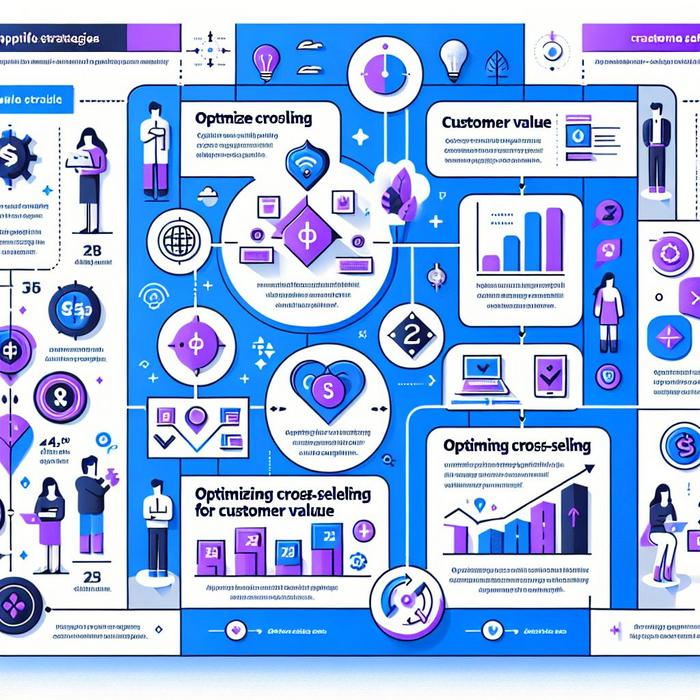Why Aren’t You Optimizing Cross-Selling to Maximize Customer Value?
Digital is rife with opportunities for businesses to maximize profits. But are you keeping pace? Did you know that by optimizing cross-selling, you can drastically increase your Customer Value? As business strategists, we must consistently ask these questions, as the answers can significantly impact business growth and profitability.
Maximizing Customer Value with Optimized Cross-Selling
With the considerable emphasis on customer acquisition strategies, one vital aspect often overlooked is the power of cross-selling. By strategically promoting related or complementary products, businesses can boost profits and make every customer interaction count. But why does cross-selling bear such significance in maximizing customer value?
- Enhanced customer experience: When businesses present relevant products, customers spend less time searching for items and make quicker buying decisions. This not only provides value to the customer, but also enhances the user experience.
- Increased revenues: Offering additional, relevant products can lead to increased sale size, which translates into higher revenue.
- Improved customer loyalty: When customers feel that their needs are understood, and that you’re providing value, it’s easier to foster long-term relationships and cultivate loyalty.
Catalyzing Customer Value with Data-Driven Cross-Selling
Understanding your customer’s needs and preferences is pivotal to success in cross-selling. Therefore, a data-driven approach can provide valuable insights into their behavior, enabling you to make informed decisions and optimize cross-selling strategies. Employing value-based optimization tactics allows businesses to tailor customer experiences and market offerings effectively, leading to maximized customer value.
Pitfalls to Avoid when Optimizing Cross-Selling
While implementing cross-selling strategies can be beneficial, mistakes can impact customer trust and satisfaction. Here are some pitfalls to avoid:
- Lack of personalization: Offering generic recommendations without considering customer preferences can lead to a poor experience.
- Irrelevant product suggestions: Presenting unrelated products might confuse customers and negatively impact their decision-making process.
- Overbearing sales tactics: Constantly pushing for more sales can overwhelm customers and deter them from engaging with your brand.
Optimized Cross-Selling: A Path Forward
It’s crucial to maintain a customer-centric approach. By facilitating positive customer experiences and providing relevant offerings, optimizing cross-selling can lead to enhanced customer relationships and maximize customer value.
An excellent starting point for your cross-selling journey is to incorporate customer-centric strategies in your business model. This ensures your organization remains focused on enhancing Customer Value and Overall Customer Satisfaction.
Ultimately, the ability to optimize cross-selling tactics and maximize customer value lies at the heart of a company’s growth. By understanding the value each customer brings and how to increase it, businesses can drive profitability and ensure long-term success. It all begins with a strategic approach to customer relationship management and the power of optimized cross-selling.
Amplifying Customer Value Through Optimized Cross-Selling
When one takes a deeper tour into the vast realm of customer lifecycle management, the strategic tool known as cross-selling emerges as one of the most potent avenues for maximizing Customer Value.
Unraveling the Power of Cross-Selling in Value-Based Optimization
Cross-selling might seem like a straightforward concept on the surface — offering companion products or services that complement an existing purchase. However, its true potential is unlocked when effectively integrated into the overarching strategy of Value-Based Optimization. It helps not just in revenue augmentation but also solidifies customer experience and bolsters customer retention, dovetailing with the ultimate goal of enhancing customer lifetime value.
To comprehend the importance of cross-selling in value-based optimization, research conducted by Madison Taylor Marketing and Census, underline how effective cross-selling can result in 70-95% of revenue being derived from existing customers.
Strategic Approach to Optimize Cross-Selling
To optimally harness the potential of cross-selling, a strategic approach that pivots around understanding and leveraging customer behavior and preferences is vital. A few key facets of this approach include:
– Identifying Cross-Sell Opportunities: Conducting deep data analytics to identify trends, patterns, and correlations between customer purchasing habits, preferences, and potential cross-sell opportunities.
– Personalizing Product Recommendations: Employing machine learning algorithms and artificial intelligence to tailor personalized product recommendations based on customer behavior and purchase history.
– Timing Your Approach: Timing is a crucial factor. It’s not just about what you offer, but also when.
Channeling Cross-Sell Strategies for Value-Based Optimization
The true success of cross-selling lies in its integration with larger customer value optimization strategies. Value-based optimization represents a paradigm shift from traditional transactional views of marketing to a more comprehensive, holistic approach centered on the individual customer’s value to the business.
Thus, incorporating effective cross-selling tactics into a larger value-based strategy means viewing each customer interaction as an opportunity to add value – to the customer’s experience and the company’s bottom line. Doing so elevates cross-selling from being a mere sales tactic to becoming a strategic tool for customer value optimization.
Such a strategic approach is underscored in an insightful exploration by New Breed Revenue, which discusses the utility of cross-selling not only as a revenue-generation tactic but also as a customer relationship enhancement mechanism. The Salesforce Learning Centre is another valuable resource that delves deeper into how cross-selling can be a potent catalyst for driving more value from customer relationships.
Similarly, Customer-lifecycle’s in-house study outlines the rewards of effective cross-selling, illustrating an optimized customer relationship lifecycle. Plus, understanding how automation can be a boon to customer relationship management, Customer-lifecycle’s take on resolving customer pain points is an essential read. Finally, the importance of optimizing customer touchpoints for enhanced customer lifetime value is well articulated in another Customer-Lifecycle piece.
By intelligently weaving cross-sell strategies into the wider fabric of customer value optimization, businesses can better engage with their customers, foster customer retention, and ultimately drive revenue growth.

